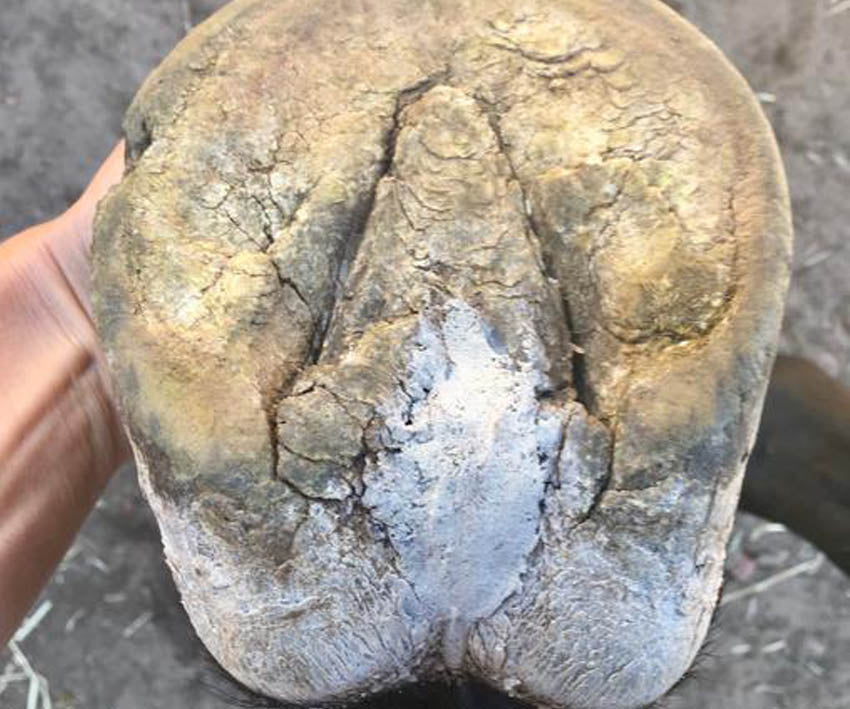
How to Detect Invisible Thrush in Horses and Treat it Effectively
Share
Most articles about thrush focus on wet thrush, which is easy to recognise by its foul smell. However, dry thrush is much harder to detect and can cause even more widespread damage to your horse if left untreated. Here is how you recognise signs of dry thrush and how you can treat it effectively.
By Helle Maigaard Erhardsen
One of the first things most horse owners are taught about hoof care is how to recognise the rotten smell of thrush. The condition is often accompanied by black, tar-like residue from either the central sulcus or from the collateral grooves around the frog. This condition is rather common for horses that are kept in wet or muddy environments, or left to stand in manure and urine drenched bedding.
However, the bacterial infection known as thrush is just as likely to occur in dry environments. According to the renowned hoof rehabilitation expert Pete Ramey, a hard, dry frog with a deeply infected central sulcus Hoof Rehab is far more painful for the horse than a soft, wet frog with the same infection.
Although an infection in a dry hoof does not necessarily smell and is not likely to discharge black residue. And even though the infection will be highly painful for your horse, it might not even show signs of lameness, as the horse could simply be altering his strides to avoid putting pressure on the sore frog and instead be landing with his toe first.
Does my Horse Have Dry Thrush?
The ACEHP certified barefoot trimmer Angie Howard of Stepping Stone Equine Hoof Care, always keeps an eye out for symptoms of thrush when she visits her clients. According to Angie, detecting dry thrush starts with knowing how your horse’s hooves look when they are healthy.
“The central sulcus shouldn’t be much deeper than a thumb print and ideally you should be able to see the bottom of it. If the thumb print starts to develop into a deep crack, there might be something in there you can’t see, and you should start your treatment,” Angie said.
Another sign of soreness in the frog can be recognised by paying attention to how your horse moves. A healthy horse should be landing confidently with his heels first and not on his toes, Angie explains:
“If you take your horse out for a good trot, the strides should be nice and long, and your horse should land with his heels touching the ground first before rolling forward onto his toes. If your horse’s strides seem short and stubby as compared to normal, you should definitely check for thrush.”

The Importance of Treating Signs of Thrush Immediately
Horse owners might not see thrush as much more than an annoyance, as it doesn’t immediately make the horse lame. However, the long term effects of an unhealthy and sore frog, can lead to an abundance of severe body issues for your horse. This is because the horse is then likely to compensate by disengaging his frog and put too much weight on his toes.
If the horse develops chronic toe-first landings, Pete Ramey has found that this can cause issues such as thin soles at the toe, recurring hoof abscesses, hoof capsule rotation, flaring of the hoof wall, wall cracks, navicular damage and injuries to the ligaments and tendons all through the horse’s leg, shoulder and back. Read more about the damaging effects of toe-first landing here.
According to Angie Howard, disengagement of the frog can also in itself be the cause of thrush and as such it can easily turn into a vicious cycle.
“A frog that doesn’t get stimulated becomes weak and is much more prone to bacterial infections like thrush. You see this in horses that avoid putting weight on an injured leg during the recovery period. But also particularly in horses that are shod, as the shoes lift their frogs off the ground and as a result the frogs don't get the stimulation they need to be healthy,” Angie said.

How to Treat Your Horse’s Thrush Effectively
Persistence is key to helping your horse get rid of thrush. You need to treat your horse’s hoof daily by cleaning the infected area and applying a remedy that will kill off both fungal and bacterial infections. Although Angie Howard advises you to be careful about which products you use:
“Many commercial products are quite harsh and contain chemicals that can harm or even kill the new tissue growing under the thrush – and that defeats the entire purpose! You want to use something that encourages new growth and treats the infection as well.”
Angie recommends using a 50/50 solution of apple cider vinegar and water to clean the infected area. Then applying a natural product that is suitable to reach the bottom of the cracks such as “Stay Put Cream” or “Hoof Clay” by Good Gear Naturals. And you need to keep at it for as long as it takes for the crack to heal and close back up.
“If there are loose flaps on the frog that prevents you from getting into the cracks properly, your qualified barefoot trimmer will cut these back. Otherwise I wouldn’t recommend trimming the frog. The heel might also have grown too high if your horse has been going toe first for a while, but never cut the heel back to normal height at once. This has to happen carefully and gradually little by little during your regular trims.”
Hoof Boots can Help in the Treatment of Thrush in Horses
When Angie Howard is out trimming, she always carries a selection of hoof boots in the case that one of her clients should be in need of some extra protection on their horse’s feet. A horse that is sore from thrush would be such a case, says Angie:
“If your horse isn’t lame you can still ride him, given that you cushion his feet with padded hoof boots and keep up with treating the thrush. This can actually help the healing process, as the boots should make your horse comfortable enough to land heel first and start stimulating the frog again.”

The grey horse is landing with his toe first while the bay horse is landing comfortably heel first wearing padded Scoot Boots.
In case your horse is too sore from his thrush to move properly, Angie recommends wearing well fitting hoof boots 24/7 during recovery to help ease the pain.
Many therapeutic boots for horses are fully enclosed which can cause bacteria to build up and that isn’t helpful whilst treating your horse for thrush. In Scoot Boots, the hooves stay clean and dry as the horse’s natural hoof heat combined with the boot’s constant airflow works to dry out the hooves in the boot.
The excellent ventilation and drainage, which expels mud, dirt and water, makes Scoot Boots a great choice for your horse during his recovery from thrush. Scoot Boots can be used while riding or they can be kept on 24/7 when needed. Adding Scoot Pads would be ideal to achieve optimal shock absorption on your horse’s sore, thrush infected feet.
Prevention of Thrush: Environment and Diet
The environment of which your horse lives in and what you feed him, are essential to his overall wellbeing. Environment meaning everything from keeping his paddocks clean from manure, to how well your paddocks are designed to encourage movement and stimulation of the hooves.
“Horses in the wild travel many miles a day across a large variety of ground such as soft pasture, rocks and gravel, sand and mud. This all helps to keep their bodies and not least their frogs healthy, which is the best prevention of thrush,” Angie explains.
As hoof health starts from the inside, it is just as crucial to steer away from sugary grasses such as rye and clover, as well as feeding grains such as barley, wheat and oats. These types of feeds contain high levels of fructose and starch, which can not only compromise the overall health of your horse’s hooves, but also cause laminitis and hindgut ulcers, according to numeral studies referenced in “Feed Your Horse Like a Horse” by PhD Juliet M Getty.
“Your horse might like these sugary and starchy feeds, but you are not doing him any favours by feeding them to him. Consider his long term health instead and he will love you for it,” said Angie.
Building a Supportive Barefoot Community
The team at Scoot Boot believe passionately in the barefoot horse and strive to build a supportive community of barefoot horse lovers.
Find more information about using Scoot Boots here.
|
About the author Helle Maigaard Erhardsen is an investigative journalist specialising in environmental issues. Her devotion to the outdoors includes a life long passion for horses of which she has two: Pannigan, an off-the-track Thoroughbred and Audrey, a Shetland pony, who are both bitless and barefoot. Helle is born in Denmark, where she graduated from the Danish School of Media and Journalism in 2015. Her work is characterised by comprehensive research and she was nominated for the special media award Bording Prisen for her investigative reporting with the newspaper Ing.dk. She later obtained a Master’s degree in Journalism, Media and Communication from UTAS, when she relocated to Tasmania. |


